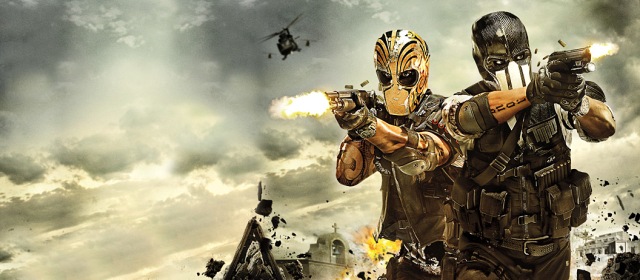Very infrequently does a console gaming series come along that manages to reach a trilogy of releases without ever really setting the sales chart on fire. The Army of two co-operative gaming franchise from Electronic Arts has joined that select group, as now a third title in the series, The Devil’s Cartel, has made its way onto home consoles with little to no fanfare.
The first title in the series introduced some interesting teamwork ideas, and the second title – the 40th Day – put in some additional morality choices throughout the game, that would effect how your gameplay developed and how you were rewarded after different actions.
Whereas the previous two games have focused on Salem and Rios, this new entry instead puts the players into the roles of two new recruits for the agency: Alpha and Bravo (names don’t get much more generic than that). Salem and Rios are in charge of T.W.O. – operating here as trainers and mentors. Alpha and Bravo are thrown straight in to helping them in their efforts to deal with Mexican Drug Cartels, which seems like a relatively simple job at first, but a series of events and a couple of twists along the way make this anything but a simple mission. Sadly, the story is so generic and given such a back seat that, even when the so-called “big twists” occur, the player isn’t likely to be that impressed; especially as most of these plot developments can be seen coming from a mile away. In fact, in-game characters joke about predicting the plot twists, which is obviously meant to be a post-modern insider joke, but this falls flat because the player is unimpressed enough with the story already.
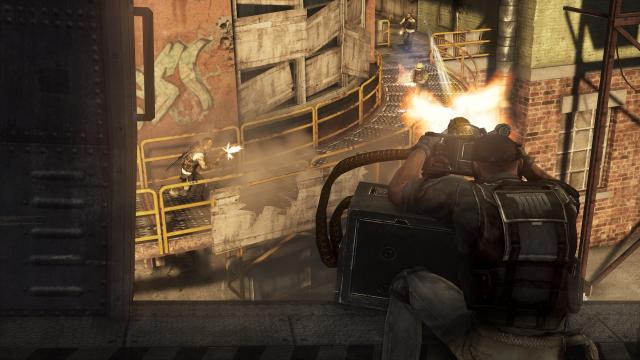
Straight-away, players who have enjoyed the last two games will probably be somewhat annoyed that they won’t get to play as Salem and Rios again. Although story has never been a major plus point in Army of Two, a certain amount of affection or rapport will have been built up, and the plot twists will only further disappoint long-time fans. But the game does still feature the two characters heavily in the story, things are just seen from another point of view. The two new unimaginatively-named guns for hire are unfortunately just that; bland stand-ins who have been brought in simply to fill a role, and have very little character development in the game. It was over halfway through the title before the two even really had any amusing banter between one another, which was always a fairly large part of previous instalments.
Considering the fact that when you first insert the disc, you will be prompted to install a high-definition texture pack, which weighs in at around 2GB, the game does little to impress visually, with or without this optional install. As it stands, the graphical integrity is let down by textures popping in and out as stages and cut-scenes load, characters clipping through objects in the environment and other such errors that certainly don’t make the game appear as if it has been given much love and attention. Nothing here screams that it has been put together with care.
The most unimpressive thing about the visuals though is probably the uninspired settings. We find ourselves in Mexico, which could be quite a colourful and vibrant setting, but instead we are treated to street after street of drab dusty roads and brown houses, which are populated by wave after wave of identical-looking, topless gang Gringos, who certainly don’t intimidate the player in any way. There is no real imagination to the settings at all aside from one location with a Mexican Day of the Dead scene, which is more aesthetically exciting than the entire rest of the game, but still seems like a missed opportunity as it is shot to pieces and breezed through with so little care. The Frostbite 2 engine that famously allows for huge amounts of environmental destruction does help to liven things up a little, with cover being blown away and almost everything in a scene destructible, but when every location is near identical, this soon loses its attraction.
Rather than a labour of love, the sound design too just seems a little bit like it has all been phoned in. The voice acting is fairly good throughout, which does help the plot come across with a little more conviction, but as previously mentioned, the script-writing this time around just doesn’t provide Alpha and Bravo with any real character or anything for players to latch on to. Supporting characters such as the big bad guy, and a friendly politician you are tasked with protecting both deliver far more interesting performances, but the story is afforded so little screen-time that they don’t have much space to shine.
Sound effects are good, as you would expect from an EA production, and some of the gunfire or explosion effects are actually really booming and do help add to the drama of the game, but this is really the only positive point from the sound design. The musical score is a background player, and rather than adding to and enhancing the gameplay experience, the music tends to get lost in the hail of gunfire and explosions. None of the music is particularly stirring, and it comes across very much as your by-the-numbers action film soundtrack – albeit with a Mexican tinge.
Being an Army of Two title, the gameplay tries to focus itself on the co-operative side of things; whether you are playing alone or with another player. The strange thing is that so many of the two-player features and actions that were made so prominent in the last two games have either been marginalised or removed entirely. For instance, the Aggro system (where one player fires at the enemy to draw fire, and their partner can then slip by unnoticed and flank them) has been minimised greatly. It used to be that there was an Aggro meter, and one player would glow Red whilst the other glowed Blue, to show who was the target and who was quiet. This meant it was easier to see how Aggro was swinging, and you could make use of the system in a better way. Now, there is no indication of this, and the system does not work as well as before. Enemies now don’t get so distracted by Aggro, and flanking is not such a big factor.
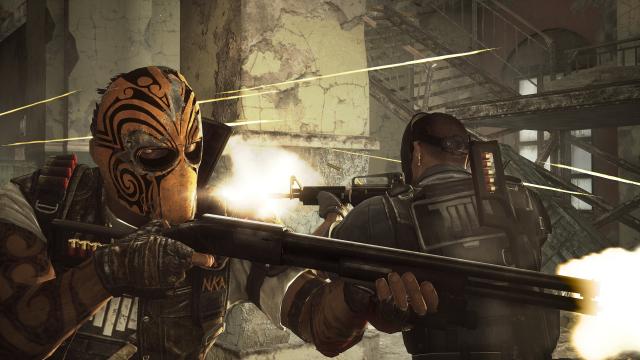
Then there are the special co-op moves. Players used to be able to stand back-to-back with their partners to unleash a spinning, barrage of bullets across the map, but this is now gone. Mock Surrender, where the player could pretend to be downed, only to spring back up and surprise the enemy is also no longer present. Players could also drag their partner around when they were downed, allowing them to continue shooting enemies, or rip a car door from the environment and use it as a shield for the two operatives, but neither of these moves made it into the third game. Even the fun tagging and co-operative sniping system is gone, despite a brief dual sniping sequence in Devil’s Cartel. These moves and features all allowed the game to stand out from the competition and gave it all an identity of its own. Taking them all out is like removing the heart of the game, and seems like such a counter-intuitive decision.
In single-player, you can give orders to your AI partner, and they are actually fairly intelligent, but this is all rather basic and is like commanding a squad, rather than playing co-operatively as brothers. The scoring system is supposed to encourage co-operative play. For instance, ten points is awarded for a normal kill, but distract a guard and get your partner to sneak around behind him and you might score 75 points. This is a little hit and miss though, and sometimes the system makes mistakes, such as awarding a surprise kill when you shoot someone in the face, or a flank when you melee someone who is attacking your partner. You’ll tend to almost ignore the scoring screens at the end of each level, because although you want to earn money in order to buy and upgrade your weapons in the weapon modification shop, the scoring won’t be at the forefront of your mind. It is nice to be able to upgrade your guns, but most of them feel the same when you are in a firefight, and you will most likely stick with your trusty Assault Rifle.
The main fun aspect is Overkill mode. As you kill, a meter fills up, and when activated by the player or their partner will make you both invincible for the duration of the meter, give you infinite ammo and make it all a lot more powerful. So during Overkill the player generally shoots at everything and anything, ripping the levels apart and destroying all in sight. This is a lot of fun, unleashing and wiping out enemies, and the dual Overkill where both players activate it at once adds even more firepower, for some crazy explosions. These sequences seem over-the-top and crazy, which fits the Army of Two idea very well, but unfortunately the rest just doesn’t match up to this, with its by the numbers environments and stereotypical level design.
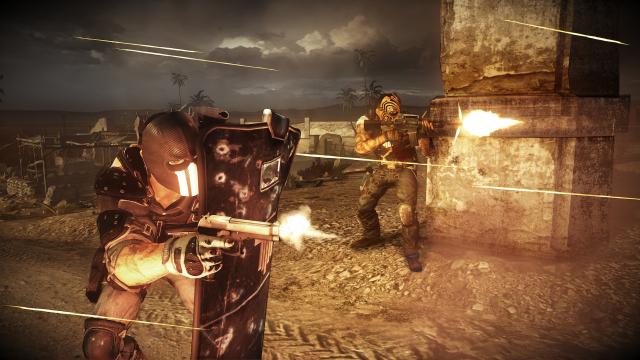
The action throughout the levels feels far too scripted, and there is no real feeling of freedom or having control of a scene. A boss will die when the game wants it to, whether you have activated Overkill or not. In a car chase scene, a truck will explode only at the point it is scripted to do so, regardless of how many bullets you have pumped into it. Not a killer flaw, as even a game like Tomb Raider has a lot of scripted moments, but then couple this issue with other niggles like the strange cover system which is always to difficult to get into when you need to, or too sticky when you want to leave cover, and it doesn’t paint a pretty picture. Or what about the invisible barriers that act as mid-level loading screens? Stopping your progress until the game catches up with you. Or there are the bugs where the level can’t be completed because the next wave of bad guys hasn’t triggered for some reason. It all feels rather unfinished and unloved, and as such isn’t going to win the affection of many fans.
The Devil’s Cartel is saved from total oblivion purely by the fact that you can play through the campaign with a friend, be it in the much forgotten split-screen mode, or online if you prefer. Playing the game with a friend is obviously how the game was intended, and this does make the title a lot more fun. Planning flanking attacks and Aggro with a friend makes the problems with the title more bearable, but it only lifts it so far, it’s still a rather monotonous experience, and even the buddy factor wears off before the campaign ends.
And then you realise that the competitive multiplayer and survival-based extraction modes from previous titles have now been completely dropped, and there are no extra options for playing the title with friends. You have story mode, and that is that, more or less. There are some technical issues with online play too. You can’t simply jump in and out of co-op online. If someone joins your game, the mission will re-start. Leave a multiplayer game, and both players have to leave. The absence of a drop-in, drop-out system is a glaring oversight, and it makes online play a clunky, irritating affair.
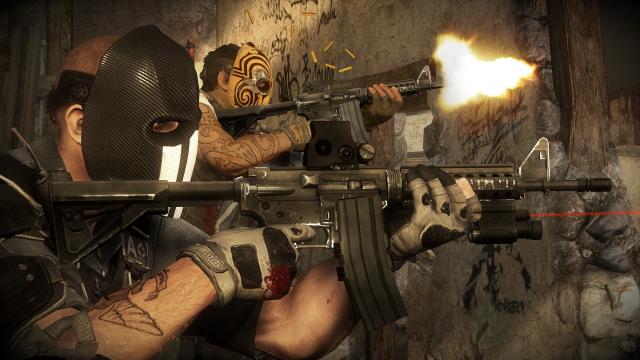
It must be said that the campaign in the Devil’s Cartel is fairly meaty. There are ten levels to work your way through, each split up into a number of smaller stages or areas. It’s by no means massive, but the length of the ten missions will keep you playing for a good 10-12 hours by itself. But therein lies the problem, because once the story has been completed, there is very little to make you want to come back and play it again. There are no different modes to speak of, apart from a handful of Contracts. These are small killzone missions that are strangely hidden away within the chapter list menu, but if you do manage to find them they just present you with short situations where the player tries to stay in Overkill for as long as possible. These won’t keep you busy for long, and after that there really is nothing else to try, especially considering that players won’t really want to play through the campaign more than once.
VERDICT: There are few positives to talk about in regards to the Devil’s Cartel. It manages to be a very perfunctory shooter, with moments of destructive brilliance with Overkill. The average gameplay is let down by the technical issues and lack of ambition in terms of design. Once army of Two was one of the few co-op games on the market, but there is nothing that will grab your attention or make this game stand out above any other co-operative shooter, of which there are now a lot. Rather than developing or evolving the positive points of the past two games, the developers have seemingly taken a step backwards in almost every way imaginable. You could even go as far as saying that they actually removed all of the interesting features from game one and two, which is truly baffling. Take away from morality choices and the two-player skills, and you are left with something very average, and a game suffering from a loss of identity.

AVERAGE. The epitome of a 50/50 game, this title will be unspectacular but inoffensive, charmless but amiable. We aren’t condemning a game by scoring it a 5, but we certainly aren’t championing it, either.


